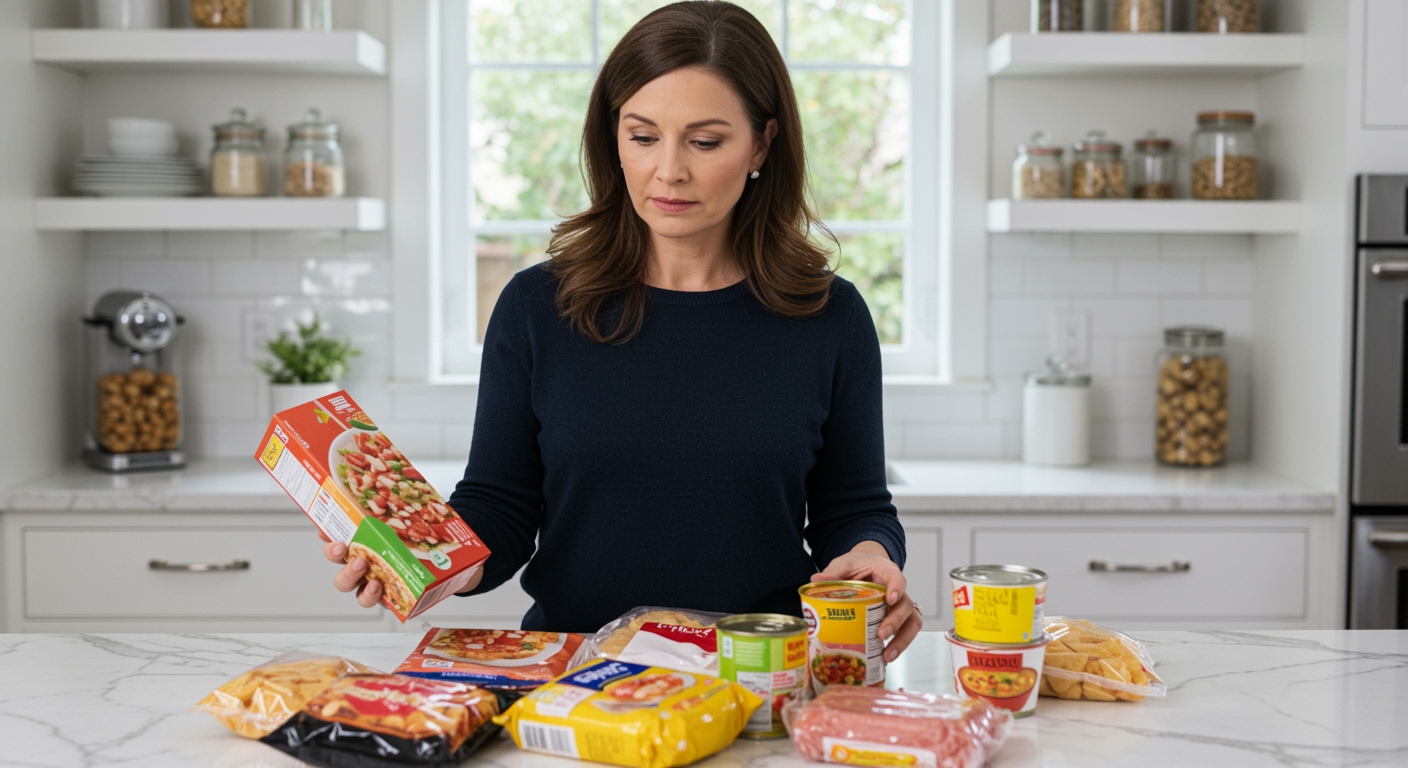✪ Key Takeaway: Hypertensive patients don’t need to avoid all convenience foods but should choose low-sodium options under 600mg per serving.
Introduction
Your doctor just told you that your blood pressure is too high and you need to watch your sodium intake.
Now you are standing in the grocery store wondering if you need to give up every single convenience food that makes your busy life manageable.
Hi, I am Abdur, your nutrition coach and today I am going to explain exactly which convenience foods you can keep and which ones you should avoid when managing high blood pressure.
Why Do Convenience Foods Get Such a Bad Reputation?
The food industry uses sodium as a cheap preservative and flavor enhancer in most processed products.
A single frozen dinner can contain up to 2300 milligrams of sodium, which equals your entire daily recommended limit.
Canned soups often pack between 800 to 1200 milligrams of sodium per serving, and most people eat the entire can thinking it counts as one portion.
Processed meats like deli turkey, ham, and sausages contain sodium nitrates and sodium chloride that can push your blood pressure readings into dangerous territory.
Restaurant meals and takeout foods use excessive salt to mask poor ingredient quality and extend shelf life.
However, not every convenience food falls into this high-sodium trap, and some companies now produce heart-healthy alternatives that fit perfectly into a blood pressure management plan.
✪ Fact: The average American consumes 3400mg of sodium daily, which is 50% more than the recommended 2300mg limit.
Which Convenience Foods Should You Actually Avoid?
Instant noodles and ramen packets contain astronomical amounts of sodium, often exceeding 1500 milligrams per package.
Frozen pizza typically contains between 700 to 1200 milligrams of sodium per slice, and most people eat multiple slices in one sitting.
Canned vegetables with added salt can contain 300 to 600 milligrams per half-cup serving, while fresh or frozen versions contain almost none.
Boxed mac and cheese mixes pack around 800 milligrams of sodium per prepared cup, not including any additional salt you might add.
Seasoning packets, bouillon cubes, and flavor enhancers are basically concentrated salt bombs that can spike your sodium intake instantly.
Fast food breakfast sandwiches, burgers, and fried chicken meals routinely contain between 1000 to 2000 milligrams of sodium per item.
✪ Pro Tip: Always multiply the sodium content by the number of servings you actually eat, not what the package claims.
What Convenience Foods Can You Still Enjoy?
Frozen vegetables without added sauces or seasonings contain virtually no sodium and often retain more nutrients than fresh produce.
Plain frozen fruits make excellent snacks and smoothie ingredients while providing natural sweetness without any added sodium.
Low-sodium or no-salt-added canned beans, tomatoes, and vegetables offer convenience without the blood pressure risks.
Pre-washed salad greens and vegetable medleys save preparation time while delivering essential nutrients your body needs.
Unsalted nuts, seeds, and nut butters provide healthy fats and protein without contributing to your sodium load.
Some frozen meals now contain less than 600 milligrams of sodium per serving, making them acceptable occasional choices when you read labels carefully.
✪ Note: Look for products labeled “low sodium” (140mg or less per serving) or “reduced sodium” (25% less than regular versions).
How Do You Make Smart Convenience Food Choices?
Always check the nutrition facts panel and aim for products containing less than 600 milligrams of sodium per serving.
Compare similar products side by side because sodium content can vary dramatically between brands for the same type of food.
Look for keywords like “no salt added,” “reduced sodium,” or “low sodium” on package fronts, but always verify with the actual numbers.
Choose products where whole foods appear first in the ingredient list rather than processed components and chemical preservatives.
Rinse canned beans, vegetables, and tuna under cold water for 30 seconds to remove up to 40% of the added sodium.
Mix convenience items with fresh ingredients to dilute the sodium concentration while increasing the overall nutritional value of your meal.
✪ Pro Tip: Keep a running total of your daily sodium intake using a simple notebook or phone app to stay within healthy limits.
The Bottom Line
You do not need to eliminate all convenience foods from your diet when managing high blood pressure, but you must become a selective and informed consumer.
Smart food choices happen in the grocery store, not at the dinner table, so invest time in reading labels and comparing options before you buy.
I would love to hear about your favorite low-sodium convenience foods or any challenges you face when shopping for heart-healthy options, so please share your thoughts in the comments below.
References
At NutritionCrown, we use quality and credible sources to ensure our content is accurate and trustworthy. Below are the sources referenced in creating this article:
- PMC: Dietary Sodium and Cardiovascular Health
- Healthline: Foods High in Sodium
- Northwest Regional Heart: 5 Foods to Skip for Better Blood Pressure
- Medical News Today: Foods to Avoid with High Blood Pressure





